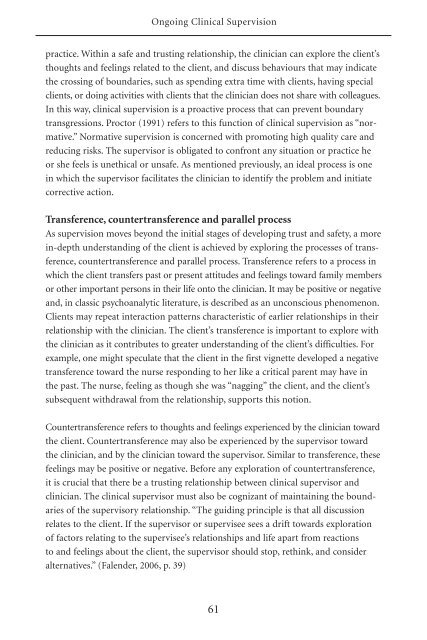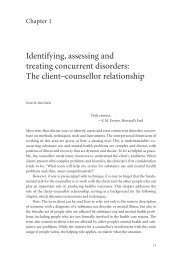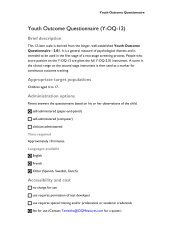Clinical Supervision Handbook - CAMH Knowledge Exchange ...
Clinical Supervision Handbook - CAMH Knowledge Exchange ...
Clinical Supervision Handbook - CAMH Knowledge Exchange ...
Create successful ePaper yourself
Turn your PDF publications into a flip-book with our unique Google optimized e-Paper software.
Ongoing <strong>Clinical</strong> <strong>Supervision</strong><br />
practice. Within a safe and trusting relationship, the clinician can explore the client’s<br />
thoughts and feelings related to the client, and discuss behaviours that may indicate<br />
the crossing of boundaries, such as spending extra time with clients, having special<br />
clients, or doing activities with clients that the clinician does not share with colleagues.<br />
In this way, clinical supervision is a proactive process that can prevent boundary<br />
transgressions. Proctor (1991) refers to this function of clinical supervision as “normative.”<br />
Normative supervision is concerned with promoting high quality care and<br />
reducing risks. The supervisor is obligated to confront any situation or practice he<br />
or she feels is unethical or unsafe. As mentioned previously, an ideal process is one<br />
in which the supervisor facilitates the clinician to identify the problem and initiate<br />
corrective action.<br />
Transference, countertransference and parallel process<br />
As supervision moves beyond the initial stages of developing trust and safety, a more<br />
in-depth understanding of the client is achieved by exploring the processes of transference,<br />
countertransference and parallel process. Transference refers to a process in<br />
which the client transfers past or present attitudes and feelings toward family members<br />
or other important persons in their life onto the clinician. It may be positive or negative<br />
and, in classic psychoanalytic literature, is described as an unconscious phenomenon.<br />
Clients may repeat interaction patterns characteristic of earlier relationships in their<br />
relationship with the clinician. The client’s transference is important to explore with<br />
the clinician as it contributes to greater understanding of the client’s difficulties. For<br />
example, one might speculate that the client in the first vignette developed a negative<br />
transference toward the nurse responding to her like a critical parent may have in<br />
the past. The nurse, feeling as though she was “nagging” the client, and the client’s<br />
subsequent withdrawal from the relationship, supports this notion.<br />
Countertransference refers to thoughts and feelings experienced by the clinician toward<br />
the client. Countertransference may also be experienced by the supervisor toward<br />
the clinician, and by the clinician toward the supervisor. Similar to transference, these<br />
feelings may be positive or negative. Before any exploration of countertransference,<br />
it is crucial that there be a trusting relationship between clinical supervisor and<br />
clinician. The clinical supervisor must also be cognizant of maintaining the boundaries<br />
of the supervisory relationship. “The guiding principle is that all discussion<br />
relates to the client. If the supervisor or supervisee sees a drift towards exploration<br />
of factors relating to the supervisee’s relationships and life apart from reactions<br />
to and feelings about the client, the supervisor should stop, rethink, and consider<br />
alternatives.” (Falender, 2006, p. 39)<br />
61

















